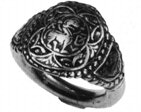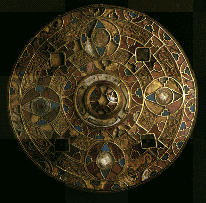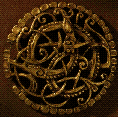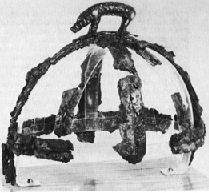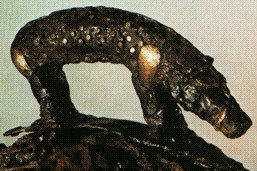A Glossary for Beowulf for Beginners
Remember to use the 'back' button on your browser to return to the main story.
avenge
To take revenge for somebody else. So to avenge a friend who has been killed
would be to kill his killer.
Barrow
A large mound of earth with a grave inside for burying a person and his belongings.
A barrow often looks like a small hill. It is by digging in some of these that
many Anglo-Saxon objects have been found.
battle standard
A battle standard is the pole and the banner which a lord's army carries
into battle.
blood-feud
This is a feud started by an act of bloodshed when somebody is killed.
Because of this killing, two groups or tribes are at war as more and more killings
take place in revenge for those who have died.
boast
Nowadays we might say that boasting is a big-headed thing to do, but to the Anglo-Saxons
it meant something quite different. A boast was a kind of promise a warrior
made in front of other people. When a warrior had boasted that he would carry
out a brave action and everyone had heard it, then he had to do it. If he succeeded
(or even if he died trying) his would be talked about and praised. If he did
not, he would not be respected any more.
bone-cage
This is another word for skeleton or rib-cage.
Craftsmen
Craftsmen are people
who are clever at making things. To make the mead-hall Hrothgar has to find
people who are skilful at building with wood, and at carving and decorating.
drinking horn
A drinking horn was usually made from the horn of a wild ox. It was polished
and decorated and used to hold wine, beer or mead. This is what a pair of drinking
horns probably looked like
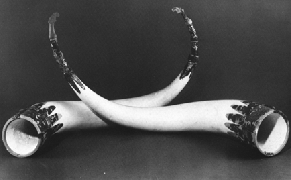
The silver parts were found in the ship-grave at Sutton Hoo.
fame
Fame was very important to warrior tribes like the Geats and Danes. Life was
short - many died in battle or from disease. What mattered was for the things
you had done while you were alive to be spoken about and praised when you were
dead. Then you would have created something that lasted longer than a life.
You could win fame by brave deeds in battle or by being a wise adviser, for
making good decisions or bringing about peace. You could win ill-fame too,
of course, for leaving your friends in battle or being a bad lord or murdering
your relatives. Fame was the way you were remembered and spoken of, the way
your story was told.
feud
A feud is a state of hatred and killing between two groups of people. It is a
war by one family or tribe against another. Often a feud can begin when a member
of one tribe kills a member of another in a quarrel. The dead person's friends
and family kill the killer, or some member of his tribe, and so it goes on.
Feuds are very difficult to stop because too many people on each side want
revenge for their loved ones who have died.
Finn the Frisian and
the Fight
at Finnsburgh
This story was well known and liked in Anglo-Saxon times. Finn,
the lord of the Frisians, married Hildeburgh, a Dane, to end a feud between
their two tribes. But when Hildeburgh's brother came with a group of Danes
to visit her, the Frisians attacked them in the night. This was especially
wicked, as the Danes were guests in the Frisians' home. Hildeburgh's brother
and her son were killed. The rest of the Danes at last managed to get revenge
and in the Fight at Finnsburgh, Finn was killed. Hildeburgh was taken home
by the Danes.
Franks, Frisians, Swedes and Hetware
The Franks, the Frisians and the Hetware were tribes living in the
areas of Europe that are now part of Germany, Holland and Belgium. The Swedes
were the neighbouring tribe of the Geats, living in the north of the country
we now call Sweden. Later on, the Franks moved south into what is now France.
The word France comes from their name.
funeral pyre
This is a huge pile of wood for burning a body at a funeral. The ancestors
of the Anglo-Saxons believed the soul left the body when it was burnt, not
at the moment when the person died. Sometimes a person's armour and other treasures
would be burnt with them.
hides
In Anglo-Saxon times land was measured in hides. One hide of land
was supposed to be enough to meet the needs of one family - for them to live
on, grow crops and graze animals. So 7000 hides of land is a very large gift
of land indeed.
hilt
The hilt of a sword is the part you hold it by. The hilts of Anglo-Saxon swords
were often beautifully decorated with jewels and complicated patterns.
holy places
These are places or buildings especially for worshipping. Anglo-Saxon holy places
were often in woods or on hills. When the Anglo-Saxons became Christians they
often built churches on the same spot. So many of the churches you can see
today actually stand on the holy places of the Anglo-Saxons.
Hrunting
The swords in Anglo-Saxon stories often have names. Beowulf's own sword is called
Naegling (you will read about it later).An Anglo-Saxon warrior depended on
his sword to save his life and kill enemies. The Anglo-Saxons admired swords
for being beautifully decorated and well-made things. A sword often lasted
longer than the life of its owner and was handed down from father to son. A
sword could see more battles than one person could. So a sword that had been
successful many times seemed to have magical powers to protect its owner and
destroy his enemies. This is why it had a character and a name of its own.
hunting with
his hawk
A hawk is a bird with hooked beak which kills small animals (like rabbits) for
food. An eagle is a type of hawk. Hawks can be caught and trained to hunt animals
for humans. This sport was popular in Anglo-Saxon times and for hundreds of years
after.

This picture shows the Anglo-Saxon King Harold out hunting with his hawk and hounds. It comes from the Bayeux Tapestry which was made by Anglo-Saxons to tell the story of the Norman Conquest.
kinsman
This is another word for relative. Beowulf is Hygelac's nephew.
mailcoats (also sometimes
called mail-shirts in the story).
Anglo-Saxon warriors wore mailcoats to protect their bodies from spears, arrows
and swords. They looked like this:
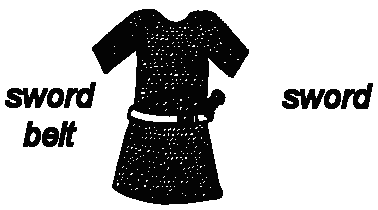
They were made of hundreds of tiny metal rings linked tightly together so that the sharp points of weapons could not easily find a way through.
mail-shirt (also called mailcoat in this story)
This is made of tiny metal rings linked tightly together. It covers the body
to protect it from spears, swords and arrows.
master
The man running away is a slave. In Anglo-Saxon society the highest
position was that of the lord or king. Then came noblemen (called thanes or
eldermen - these were usually warriors or advisers). There were also the farmers
(called churls) and slaves. A slave could be bought and sold like a cow or
a pig. Some slaves were born the children of slaves. Some became slaves after
being taken prisoner in wars. Sometimes people sold themselves into slavery
just to have enough to eat. Sometimes when the slave-owner died, their will
said that their slaves should be set free.
Mead-hall
The word 'mead-hall' means a place for drinking 'mead'. Mead is a drink
made from honey. The Anglo-Saxons liked to drink mead, wine and beer. The mead-hall
was a building where everyone could meet together.
mere
A mere is another word for a lake or pool. You can still see this word in place-names
today - for example, Lake Windemere in the Lake District.
ninth hour
of the day
The Anglo-Saxons counted the hours of the day beginning from 6 o'clock in the
morning. So the ninth hour is 3 o'clock in the afternoon.
offerings
These are gifts that people make to please the gods so that they will answer
their prayers. When the ancestors of the Anglo-Saxons still lived in Sweden
and Denmark they sometimes killed people to give them as offerings to the gods.
These offerings - or 'human sacrifices' - were to please the earth-goddess.
The bodies of some of these people have been found in large bogs in Sweden
and Denmark. The bodies did not decay because the peat in the bogs kept them
whole.
olden
days of the Giants
This is a story from the Bible, which says that once a race of Giants lived on
the earth. They were at war with God. The people grew wicked too, so God sent
a great flood to punish and destroy all this wickedness. Noah and his family
were saved, along with two animals of every kind, because Noah kept them safe
in his Ark while the earth was flooded. Grendel and his mother are supposed to
be related to this race of Giants who once ruled the earth.
reputation
Your reputation is how you are known among your group (or tribe). You can have
a reputation for being a coward, or clever, or funny. It is what people know
or say about you. A warrior's reputation must be that he is brave and willing
to face danger. Unferth loses his reputation as a brave warrior because he
does not dare to face Grendel's Mother. For the Anglo-Saxons, reputation was
connected to fame (how a person was talked about after he or she was dead)
and was very important.
rings
As you know from the story, the lord often gave gifts to his warriors
at feasts. As well as weapons and armour, he might give rings like these:
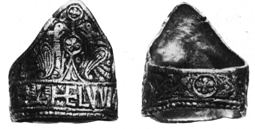
or this
Or brooches:
These might have been used for fastening a cloak.
swan's riding-place
The 'swan's riding-place' is the sea. The Anglo-Saxons liked to make word-pictures
like this, especially in poetry. For example, the sun is called 'the sky's
candle' later in the story. The Anglo-Saxons used at least fifteen different
words for the sea - another example is 'whale-road'.
tapestries
Tapestries are pictures sewn onto cloth or woven out of thread. Large
tapestries often hang on the walls in castles.
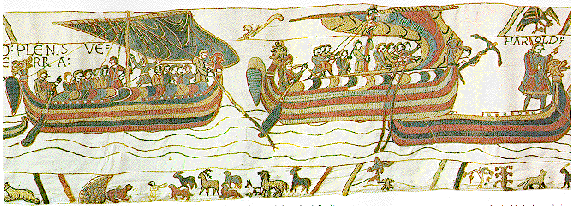
These ships are part of the Bayeux Tapestry. The tapestry was made soon after William the Conqueror and the Normans conquered the Anglo-Saxons in 1066. It was made by Anglo-Saxons and tells the story of their defeat by the Normans
Watchman The group of soldiers on guard against enemies is often called the Watch. Here, the man in charge of these soldiers looking out for raiders from the sea is called the Watchman.
Whale road
The 'whale-road'
is the sea. The Anglo-Saxons liked to make word-pictures like this, especially
in poetry. For example, the sun is called 'the sky's candle' later in the
story. The Anglo-Saxons used at least fifteen different words for the sea
- another example is 'swan's riding-place'.
wild boars
A wild boar is a male wild pig. They used to be common in Britain and still live
in countries like Poland in Eastern Europe. They are large and hairy and have
very sharp tusks. They can be very fierce and dangerous. Beowulf's helmet is
decorated with them to frighten his enemies.
This is an Anglo-Saxon helmet with a boar on top. It was found at a place called Bentley Grange
